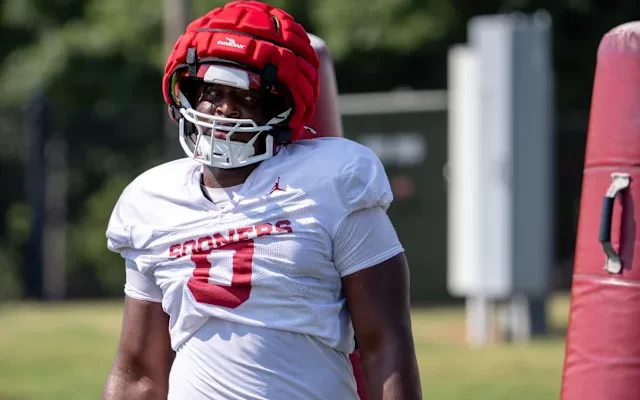Oklahoma suffers a significant roster shake-up as former five-star defensive lineman David Stone officially enters the transfer portal, marking a major departure from the Sooners’ defensive front.
The Oklahoma Sooners were dealt a significant and unexpected blow with the departure of one of their most promising young talents, as former five-star defensive lineman David Stone officially entered the NCAA transfer portal. The news sent shockwaves through the Oklahoma fanbase and college football community, not only because of Stone’s immense potential but also because of what his decision represents for a program trying to reassert itself as a national powerhouse under head coach Brent Venables.
David Stone arrived in Norman with the kind of hype few high school prospects ever experience. A product of IMG Academy and a consensus five-star recruit, Stone was one of the crown jewels of Oklahoma’s 2024 recruiting class. The Sooners had beaten out traditional heavyweights like Alabama, Michigan, Florida, and Miami for his signature, and his commitment was seen as a major validation of Venables’ defensive-minded recruiting strategy. For a team aiming to rebuild its identity on the defensive side of the ball, Stone was supposed to be a foundational piece—both a disruptive force on the field and a symbol of what the new era of Oklahoma football could become.
From the start, Stone carried the expectations of a fanbase eager to see dominant defensive line play once again in Norman. He had the rare combination of size, athleticism, explosiveness, and technique that made him a nightmare for opposing offensive lines. Listed at 6-foot-4 and nearly 280 pounds, Stone could line up at multiple spots across the defensive front, giving Venables and defensive coordinator Ted Roof tremendous flexibility. His high school tape showed a player with elite burst off the line, powerful hands, and a relentless motor—traits that made him nearly unblockable against lesser competition and highly intriguing at the Power Five level.
Yet, despite the sky-high expectations and his undeniable potential, Stone’s freshman year in Norman came with growing pains. Like many highly touted recruits transitioning to college football, he had to adjust to the speed and physicality of the game. While flashes of brilliance were there, he did not immediately step into a starting role or become the instant game-changer some had predicted. Developmental challenges, competition in the defensive line room, and adapting to the demanding structure of a collegiate program all likely played a part in his trajectory.
Still, his presence alone was enough to generate optimism about the defensive line’s future. Coaches regularly spoke highly of his work ethic, upside, and willingness to learn. As spring football arrived and preparations for the 2025 season began, many believed Stone was poised for a breakout sophomore campaign. He had added muscle, improved his technique, and seemed ready to take on a larger role. And with Oklahoma making the historic transition into the SEC, his development was seen as essential to competing in the trenches against the likes of Georgia, LSU, and Alabama.
That’s why the timing of Stone’s decision is so jarring. Entering the portal just ahead of the season’s final prep phase raises difficult questions for the Sooners’ coaching staff and the program’s internal dynamics. Was the decision purely about playing time, or were there other factors at play? Did NIL opportunities at other schools pull him away, or was there a deeper dissatisfaction that hadn’t surfaced publicly? In today’s college football landscape, where player movement is more frequent and complex than ever before, fans are left to piece together speculation with limited insight.
Stone’s exit also creates a domino effect across Oklahoma’s defensive front. The staff now has to re-evaluate its depth chart and potential starters at one of the most critical positions on the field. What was expected to be a strength of the team now looks less certain. Younger players will have to step up faster than anticipated, and incoming freshmen may be thrust into more prominent roles. Veterans who were expected to rotate or provide situational support might now find themselves carrying greater responsibility throughout the season.
The broader implications of his transfer also touch on Oklahoma’s reputation in the recruiting world. Losing a five-star recruit this early in his career raises questions among future prospects about development, culture, and opportunity in Norman. Competing in the SEC means attracting—and keeping—elite talent. If highly touted recruits begin to feel that their growth is stalling or that they are better served elsewhere, that perception can hurt long-term recruiting momentum.
At the same time, Venables and his staff have to walk a fine line between being flexible in a player-driven era and maintaining a culture that prioritizes commitment and competition. The transfer portal era has changed everything. It allows players to make quick decisions about their futures, often based on factors like NIL packages, proximity to home, coaching relationships, or immediate playing time. While those freedoms have empowered athletes, they’ve also created instability, especially for programs trying to build continuity.
David Stone’s departure might be the latest high-profile example of this new reality. No longer can programs assume that elite talent will stick around if things don’t click immediately. Stone likely has dozens of programs already lining up to make their pitch, and wherever he lands, he’ll be expected to fulfill the same promise he carried into Norman. There’s little doubt he’ll be one of the most sought-after names in the portal, and it wouldn’t be surprising to see him land at another major SEC or Big Ten power.
For Oklahoma, the road forward requires adaptability and urgency. The coaching staff must continue recruiting relentlessly—not just at the high school level, but also in the portal. They need to plug roster gaps quickly and assure their current players that the program remains committed to development and success. They’ll need to ensure that the loss of Stone doesn’t fracture locker room morale or lead to a broader sense of instability. Leadership within the team, especially among upperclassmen, will be crucial in weathering this storm.
It’s also a moment for reflection. Programs around the country are learning that five-star talent alone doesn’t guarantee wins or long-term program health. The emphasis now must also be on retention, culture-building, and maximizing each player’s potential through individualized development plans. The loss of David Stone is disappointing, but it can serve as a catalyst for growth if the Sooners use it as a learning experience to strengthen their systems and support structures.
For the fans, this news is particularly painful because it feels like the loss of a dream before it ever materialized. Stone wasn’t just another highly ranked recruit—he was a symbol of Oklahoma’s defensive future. Losing him is about more than statistics or depth charts; it’s about seeing a vision potentially derail before reaching its full form. Still, college football has always been a game of ebbs and flows, of unexpected turns, and of next-man-up mentalities. The Sooners have weathered adversity before and must do so again.
In the end, Stone’s story is still unwritten. He could thrive at his next stop and eventually hear his name called early in the NFL Draft. Oklahoma, too, could find new stars on the rise who fill his void and perhaps even surpass the expectations originally placed on him. The reality is that both player and program have difficult choices to make in the modern era. Sometimes those paths split earlier than anticipated.
As Oklahoma prepares for its SEC debut, they’ll do so without one of the players they hoped would be a face of that transition. The loss stings—but it’s also a reminder of how volatile the journey can be in the current college football climate. What remains is the task of turning setbacks into opportunities, rebuilding where necessary, and moving forward with resolve. Because in Norman, the expectation isn’t just to compete—it’s to win. And even without David Stone, that mission continues.



